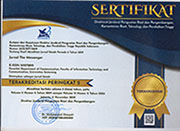(Opportunities) Death of Newspaper Industry in Digital Age and Covid-19 Pandemic
Abstract
Newspaper industry is entering a state of emergency in Indonesia. Dewan Pers demands that the government provide incentives to press companies during Covid-19. The growth in the number of internet users, the downward trend in advertising revenue, and the number of newspaper circulation are problems in the print media business. List of questions in this study: what are the trends in the use of internet technology and social media in Indonesia?; why did various newspaper companies in Indonesia collapse and die in the digital era?; how is the effort to save the newspaper business? Meanwhile, the research paradigm is qualitative. The time of the study is November 2019 to May 2020. The results of this research, the growth in the number of internet users has been extraordinary in the last 20 years. Signs of the newspaper era are over, strengthened by many newspaper companies turning to online media. The number of readers fell, the number of advertisers plummeted, number of copies narrowed, and the cost of producing newspapers became increasingly expensive to cause the closure of various newspaper companies. Rescue by attracting young readers and doing various innovations. Tragically, the print media industry will end and die on its own.
Keywords
Full Text:
PDFReferences
Adiprasetyo. (2008). Pemanfaatan Grey Literature di Perpustakaan. Jurnal Media Informasi Dan Komunikasi Kepustakawanan:, 3(2).
Adv. (2013). Ganti Wajah, Koran SINDO Ciptakan Generasi Semangat Baru. detik.com.
Altig, D., Baker, S. R., Barrero, J. M., Bloom, N., Bunn, P., Chen, S., Davis, S. J., Leather, J., Meyer, B. H., Mihaylov, E., Mizen, P., Parker, N. B., Renault, T., Smietanka, P., & Thwaites, G. (2020). Economic Uncertainty Before and During the COVID-19 Pandemic (No. 27418; Working Paper). https://doi.org/10.3386/w27418
amb. (2008). Pabrik Kertas Terpaksa Tutup. Kompas. https://nasional.kompas.com/read/2008/03/31/22222261/pabrik.kertas.terpaksa.closed
Artini. (2017). Media Perception of the Development of Digital Technology. Journal of the Press Council Edition, 15.
Baker, S. R., Bloom, N., Davis, S. J., Kost, K. J., Sammon, M. C., & Viratyosin, T. (2020). The Unprecedented Stock Market Impact of COVID-19 (No. 26945; Working Paper). https://doi.org/10.3386/w26945
Barus, S. W. (2010). Journalism: Technical Guidelines for Writing News. Erlangga.
Bell, E. J., Owen, T., Brown, P. D., Hauka, C., & Rashidian, N. (2017). The Platform Press: How Silicon Valley Reengineered Journalism. https://doi.org/10.7916/D8R216ZZ
Crosbie, V. (2004). Representative American Speeches 2004-2005. Broadcast Education Association.
Dewan Pers. (2020a). Data Perusahaan Pers. Dewan Pers. https://dewanpers.or.id/data/perusahaanpers
Dewan Pers. (2020b). Sertifikasi Wartawan. Dewan Pers. https://dewanpers.or.id/data/sertifikasi_wartawan
Hasni, Nur, Cangara, H., & Fatimah, J. M. (2019). Endurance of the Print Media Business in the Middle of the Rise of Online Media Use in Makassar City (Fajar Daily Newspaper and East Tribun Daily Newspaper). Journal of Communication Science Medialog, 2, 41 53.
Hill, J. (2016). Strategies for a Turbulent Future? in a book called: The British Newspaper Industry: The Future of the Regional Press. Palgrave Macmillan.
Internet Live Stats. (2020). Internet Usage & Social Media Statistics. Internet Live Stats. https://www.internetlivestats.com/.
Jyrkiainen, J. (2015). Newspaper Chains in Finland 1993 2010. Journal of Media Business Studies, 9(2). https://doi.org/10.1080/16522354.2012.11073541.
Kartinawati, E. (2017). Cloning Journalism among Journalists in Surakarta City. The Messenger Journal, 9(1).
Kemp, S. (2020). POSTS TAGGED DIGITAL 2020. Datareportal. datareporta
Kristensen, L. B. K., & Solvoll, M. (2019). Digital Payments for a Digital Generation: Disruptive Technology in Book and Local Newspaper Industries. Nordic Journal of Media Studies, 1(1), 125 136.
Kusuma, S. (2016). Print Media Position in the Middle of Online Media Development in Indonesia. Interact Journal, 5(1), 56 71.
Lebo, H. (2012). World Internet Project International Report. https://www.digitalcenter.org/reports/
Meyer, P. (2009). The Vanishing Newspaper: Saving Journalism in the Information Age. University of Missouri Press.
Miller, J. W., & McKenna, M. C. (2016). World Literacy: How Countries Rank and Why It Matters (World s Mo). Routledge.
Murdoko Sudarmadji, A., & Sularto, L. (2007). Pengaruh Ukuran Perusahaan, Profitabilitas, leverage, dan Tipe Kepemilikan Perusahaan Terhadap Luas Voluntary Disclosure Laporan Keuangan Tahunan. Seminar Ilmiah Nasional PESAT 2007.
Pew Research Center. (2006). The Future of News Magazines. Pew Research Center.
Rahim, S. A. (2018). Digital Experience and Citizen Participation in Bridging Ethnic Divide: An Analysis of Young Generation in Malaysia. Jurnal Komunikasi Malaysian Journal of Communication, 34(4), 154 167. https://doi.org/10.17576/JKMJC-2018-3404-09
Sjafiie, S. S. L., Hastjarjo, S., & Muktiyo, W. (2018). Graphic Visualization in Printed Media: How Does the Use of Technology Influence Journalism Culture. Jurnal Komunikasi Malaysian Journal of Communication, 34(4), 373 385. https://doi.org/10/17576/JKMJC-2018-3404-22
Subekti, S. (2020). Kantor Berita Australia, AAP, Tutup Setelah 85 Tahun. Retrieved. Satuharapan. kantor-berita-australia-aap-closed-after-85-tahun
Supadiyanto. (2014). Implementasi Teknologi Internet untuk Harian Jogja tentang Kebijakan Editorial dalam Orde Reformasi [Universitas DIponegoro]. http://eprints.undip.ac.id/45564/
Supadiyanto. (2013). Implikasi Teknologi Digital dan Internet untuk (Paperless Newspaper) pada Industri Media Cetak di Indonesia. SEMINAR NASIONAL Seri 3 Menuju Masyarakat Madani Dan Lestari 2013, 687 696. https://dppm.uii.ac.id/index.php/2013/12/
Taibi, M., & Na, T. Y. (2020). The Changes of Media Landscape in Malaysia: How Citizen Journalism Poses Threats to Traditional Media. Jurnal Komunikasi: Malaysian Journal of Communication, 36(1), 396 380.
Tanikawa, M. (2017). What Is News? What Is the Newspaper? The Physical, Functional, and Stylistic Transformation of Print Newspapers 1988 2013. International Journal of Communication, 11.
Tempo. (2013). Daftar Media Cetak Amerika yang Gulung Tika. Tempo.Co. http://www.tempo.co/read/news/2013/08/06/116502699/List-Media-Print-Amerika-yang-Gulung-Tikar
Thompson, S. (2013). The Future of Newspapers. In K. Fowler-Watt & S. Allan (Eds.), Journalism: New Challenges. Centre for Journalism & Communication Research Bournemouth University.
Usher, N. (2010). In a Hamster-Wheel World, is There Room for Journalistic Creativity? Evidence from The New York Times. NeimanLab. http://www.niemanlab.org/2010/09/in-a-hamster-wheel-world-is-there-room-for-journalisticcreativity-evidence-from-the-new-york-times/.
Villi, M., & Hayashi, K. (2017). The Mission is to Keep this Industry Intact : Digital Transition in the Japanese Newspaper Industry. Journalism Studies, 18(8), 960 977. https://doi.org/10.1080/1461670X.2015.1110499.
Wikan, A. (2017). Press Strategy in the Middle of Disruption. Journal of the Press Council, 15.
Wilson, S. M. (2005). Preserving the American Community Newspaper in an Age of New Media Convergence and Competition. Georgia State University.
World Health Organization. (2020). Coronavirusdisease (COVID-19) Situation Report 10. World Health Organization. https://www.who.int/docs/default-source/coronaviruse/situation-reports/20200503-covid-19-sitrep-104.pdf?sfvrsn=53328f46_2.
Wulan, S. (2015). Memahami Kebijakan Redaksional Rubrik Pendidikan di Surat Kabar Harian Solopos. Jurnal The Messenger, 7(2).
DOI: http://dx.doi.org/10.26623/themessenger.v12i2.2244
Refbacks
- There are currently no refbacks.
Copyright (c) 2020 Jurnal The Messenger
View My Stats [Jurnal The Messenger] is an International Scientific Journal, Published by the Department of Communication, Faculty of Information Technology and Communication, Universitas Semarang (Central Java, Indonesia). It is licensed under a Creative Commons Attribution 4.0 International License.



_11.jpg)




_BARCODE.jpg)
_BARCODE1.jpg)


5.png)










2.png)





